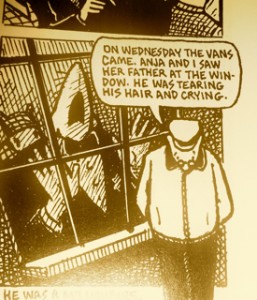 This is the first graphic novel I’ve ever read and I couldn’t put it down. It is in fact a novel I have heard much about and had intended to read over the years. I am glad to have had the opportunity to do so now.
This is the first graphic novel I’ve ever read and I couldn’t put it down. It is in fact a novel I have heard much about and had intended to read over the years. I am glad to have had the opportunity to do so now.
Interesting how Spiegelman uses the traditionally “low” form of the comic book to treat a very very serious and grave subject matter. Subversive!
I found the “visual rhetoric” striking and powerful. Spiegelman’s specific animal representations are potent. First off, the choice to portray the Jews as mice of course brings up the Nazi representation/metaphors of Jews as rats. The cats (Nazis) and the pigs (Poles) elicit associations of cunning and greed/plenty; also of cat as aggressor/oppressor and mouse as victim/oppressed. There is something reductive and stereotypical about the visual representations, which reflects the horrific reductive nature of Nazism and anti-Semitism.
The visual/graphic format itself also recalls the “Protocols of the Elders of Zion” – Nazi anti-Semitic propaganda.
Interesting how many different types of texts lie within the text: diagrams, photographs, detailed plans, and maps… There are narratives within narratives, and a fluid interplay between image, narrative, and dialogue.
In my own reading, I noticed that I am far more text centered than image centered. My eyes followed the words and I actually found myself forcing myself to slow down and pay attention to the illustrations at times. The image that won’t leave me is that of Anja, mouth agape. Throughout most of the book, the mouths of the characters (mice) are closed. When they’re open they are portraying cries and screams, lending a humanity and vulnerability that is heart wrenching.
5 replies on “Maus — the horror and fragility of an open mouth!”
oh man my image didn’t upload. Gonna try again.
I was going to also mention the idea of the masks, where sometimes the mice wear pig masks to disguise themselves as poles, raises questions of identity, moving between identities, to what degree identity is lodged in appearance… Very powerful stuff!
I agree: this is an excellent, if difficult, graphic novel. Thanks for your post, Dana! Email me and we’ll try to get the image uploaded.
One thing I do think we need to interrogate is the notion of the “low form.” Consider the fact that novels developed as a “low form” in the 18th C. Now they are the most successful form of literary art and certainly are not generally thought of as somehow substandard. What are the politics of text that validate some forms and not others? This question is certainly tied to our earlier discussions of ELA as a discipline solidly tied to the project of empire building . . .
Teresa
Oh I agree that we must interrogate the notion of the “low form” and that it is loaded with dynamics of (unbalanced) power relations. That’s why I put it in quotation marks!
OK, I will email you the image!
I am going to post myself about my graphic novel experience but I had to comment here as well that the biggest hurdle was making myself look at the pictures! I am glad it wasn’t just me! haha